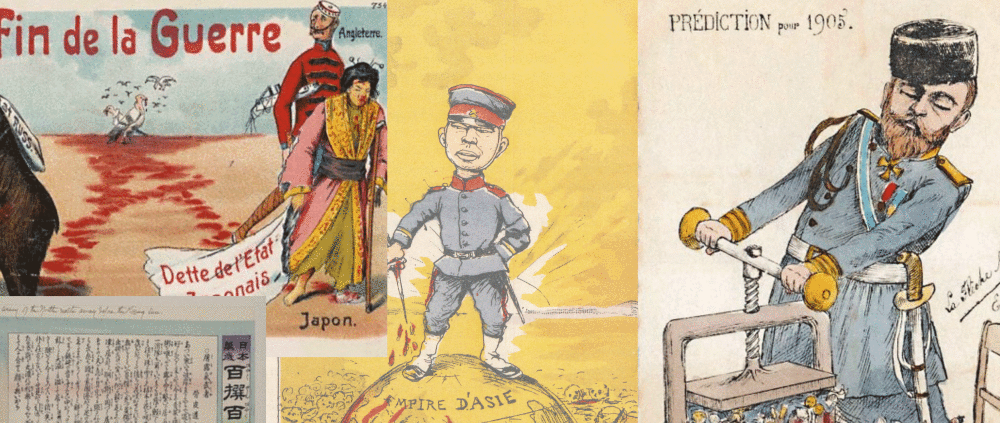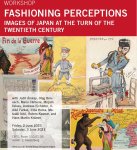Workshop: Fashioning Perceptions

Workshop
FASHIONING PERCEPTIONS
IMAGES OF JAPAN AT THE TURN OF THE TWENTIETH CENTURY
Hybrid-Event: CATS, 010.01.05 and Online via Zoom
Day 1 – The Changing Image of Japan around the Russo-Japanese War
Friday, 2 June 2023, 2 pm – 6 pm
|
14:00 |
Welcome and Introduction: Judit Árokay, Heidelberg University |
|
14:10 |
Keynote Lecture by Rotem Kowner, University of Haifa (Online): The Global Impact of the Russo-Japanese War and Japan's Changing Images |
|
15:10 |
break |
|
15:20 |
Ildikó Farkas, Károli Gáspár University, Budapest: The Changing Perceptions of Japan in East Central Europe at the Beginning of the 20th Century |
|
16:05 |
break |
|
16:15 |
Maria Cărbune, Heidelberg University (Online): Literary Translation as Wartime Diplomacy. Suematsu Kenchō and Emperor Meiji’s Waka Poetry during the Russo-Japanese War |
|
17:00 |
break |
|
17:10 |
Andreas Eichleter, Heidelberg University: The ’Deutsche Japan Post’ (Yokohama) and the Russo-Japanese War |
Day 2 – Self-Image of Meiji Japan – Shaping New Perceptions
Saturday, 3 June 2023, 9 am – 3:30 pm
|
9:00 |
Motoaki Ishii, Osaka University of Arts (Online): Meiji Art Export and Meiji Self Image: The Case of Italy |
|
9:45 |
Mirjam Dénes, Ferenc Hopp Museum of Asiatic Arts, Budapest (Online): From Japonisme to Post-Japonisme: Changes in the Reception of Japanese art on the European Market |
|
10:30 |
break |
|
10:45 |
Irina Holca, Tokyo University of Foreign Studies (online): Japan in the Romanian Literary Imagination, before and after the Russo-Japanese War |
|
11:30 |
Ildikó Farkas, Károli Gáspár University, Budapest: Japanese Efforts against the „Yellow peril” Propaganda: The Case of a Hungarian Orientalist and the Japanese Image after the Russo-Japanese War |
|
12:15 |
break |
|
13:30 |
Oleg Benesch, University of York: Presenting Bushido and the Samurai as Japanese Essence and Global Standard |
|
14:15 |
Hans Martin Krämer, Heidelberg University: Changing Images of Japanese Buddhism in Europe? |
|
15:00 |
Final Discussion |
Workshop Abstract
While in the second half of the 19th century, Japanese art, literature, knowledge of certain forms of Buddhism and the martial arts had already reached Europe and contributed to a positive image of Japanese culture, the wars against China and Russia changed the perception of Japan radically. In the wake of the Japanese victory over Russia, the image of the Yellow Peril was revived and Japan came to be seen as a threat to the Western world. At the same time, we also see differences in the perception of Japan in Europe, between the Western part and Central and Central Eastern Europe, testifying to the complexity of cultural flows.
The time frame of our workshop will be the years right before, during and after the Russo-Japanese War and the question how Japan was seen in the rest of the world and concretely in some of the European countries, like Germany, Hungary, and Romania. We will try to trace the changing images of Japan, and focus on the question how Japan itself was shaping its own perception on an international scale. Diplomats, translators, activists, masters of Japanese arts were engaged in different ways in refurbishing the image of Japan to win favor in the world.
Abstracts of all Lectures
Friday, 2 June 2023
-
Keynote lecture by Rotem Kowner: The global impact of the Russo-Japanese War and Japan's changing images
The Russo-Japanese War was fought for 19 months (8 February 1904 - 5 September 1905) between the empires of Japan and Russia over the southern part of Manchuria and the Korean Peninsula. While considered by its contemporaries to be a colonial war, its repercussions were global. In this presentation, I will discuss the wide-ranging impact of the war and the role it played in changing the image of Japan and its people. -
Farkas Ildikó: The changing perceptions of Japan in East Central Europe at the beginning of the 20th century
Ideas about the East and the relationship with the East (“orientalism”) were not only of cultural significance to the peoples of East Central Europe, but also played a role in shaping their collective identity in their relationship with the West. The example of the successful Japanese development by the beginning of the 20th century – which itself was greatly influenced by the Western development – had a significant effect on the discourses of identity and modernity of the peoples of this region. Japan was seen to accomplish modernization while preserving its traditions, thus solving the dilemma of almost every non-Western country: changing its cultural horizon without losing its identity. -
Maria Cărbune: Literary translation as wartime diplomacy. Suematsu Kenchō and Emperor Meiji’s waka poetry during the Russo-Japanese War.
This paper examines the diplomat and statesman Suematsu Kenchō's 末松謙澄 literary translations of Emperor Meiji's waka poetry during the Russo-Japanese War (1904 - 1905). I focus on the textual strategies of the translations and the panegyric, nationalist framing of Suematu's accompanying commentaries. In doing so, I reconsider the act of literary translation as a political self-representation of the state at the turn of the 20th century. -
Andreas Eichleter: The Deutsche Japan Post and the Russo-Japanese War
The Russo-Japanese War of 1904-05 was one of the first major international conflicts of the 20th century and closely followed by people around the world, being not merely a military conflict but a media phenomenon which reflected contemporary prejudices and perceptions. It was also one of the watershed moments that established Japan’s position as a great power, and its defeat of Russia was hailed as a major achievement for this rising power. In this presentation, I will take a look at the Russo-Japanese War and the image of Japan as portrayed in the Deutsche Japan Post, a German-language newspaper published in Yokohama from 1902 to 1914.
Saturday, 3 June 2023
-
Motoaki Ishii (online): Meiji Art Export and Meiji Self Image: The Case of Italy
After a general panorama of the evolution in the late Tokugawa Shogunate and the beginning of Meiji Era, Japan’s reactions both in Venice Biennale of 1897 and Double World Fair in Rome and Turin of 1911 will be verified. -
Mirjam Dénes (online): From Japonisme to Post-Japonisme? Changes in the reception and perception of Japanese art in Europe (1900 - 1912)
Japonisme reached its peak roughly around 1900, when the Paris International Exposition was held. But what comes after the peak? A decline? Or a second wave? In this presentation we will look into what happens to Japonisme right before, during and right after the Russo-Japanese War and ponder the questions whether the changing political perception of Japan had an impact on the aesthetic and artistic reception and perceptions of Japan in the short and in the long run, and if it did, how it manifested itself. -
Irina Holca (online): Japan in the Romanian Literary Imagination, before and after the Russo-Japanese War
In this presentation, I plan to first look at the way Japan's image was shaped in late 19th century Romanian travelogues and other similar discourses. Next, I will analyse how this image is "re-focused" at the beginning of the 20th century by carrying out a close reading of Sofia Nadejde's novel Irimel, which follows the life of a Romanian young man fighting in the Russo-Japanese War. -
Ildikó Farkas: Japanese efforts against the „Yellow peril” propaganda: The case of a Hungarian orientalist and the Japanese image after the Russo-Japanese War
The paper examines the wider context of writings against „Yellow Peril” after the Russo-Japanese War, presenting several different motives getting connected: the changing image of Japan, the Japanese efforts to influence this image, the different perception of Japan in East Central Europe, and the case of the Hungarian scholar Arminius Vambery, who was an internationally well-known Orientalist and was known as a committed supporter of Asian cultures. -
Oleg Benesch: Presenting Bushido and the Samurai as Japanese Essence and Global Standard
Although the samurai warriors were effectively abolished in the 1870s, their high point as national symbols of Japan arguably took place three decades later, around the time of the Russo-Japanese War. This global explosion of interest in the samurai was typically framed in the context of bushido, the “way of the warrior” or “way of the samurai”. Bushido was itself largely an invention of the 1890s, also as a response by Japanese thinkers to European ideals of chivalry and gentlemanship. These were part of a medievalist revival of global proportions that could not be overlooked by societies that encountered the European empires in the late nineteenth century. This paper examines how, by 1905, Japan had developed its own idealized medievalist narrative around the former samurai, which was in turn broadly accepted in the West and around the world. Using Robert Baden-Powell’s Boy Scout movement and the context of Anglo-Japanese relations, this paper argues that bushido and the samurai were portrayed as uniquely Japanese, while simultaneously being accepted as part of an emerging global standard for medievalist martial ethics in the early twentieth century. -
Hans Martin Krämer: Changing Images of Japanese Buddhism in Europe?
Up to around 1900, European images of Japanese Buddhism were mostly negative, sometimes starkly so. Japanese Buddhists tried to counter this by publishing in European languages, an effort that became more visible since the turn of the twentieth century. It is debatable, however, if their efforts were successful, as it was arguably only the Zen boom much later in the twentieth century that really managed to change Western perceptions of Japanese Buddhism.


